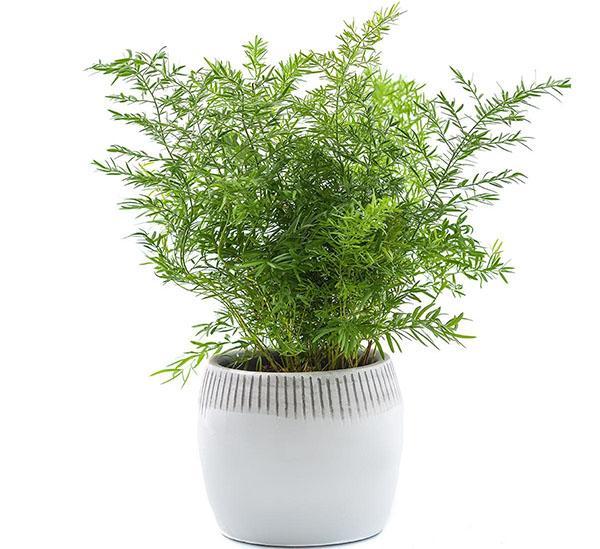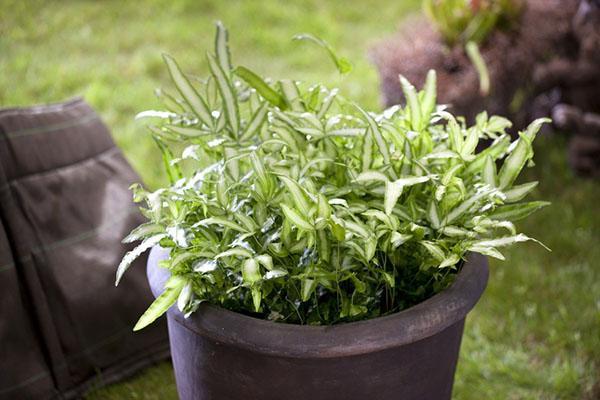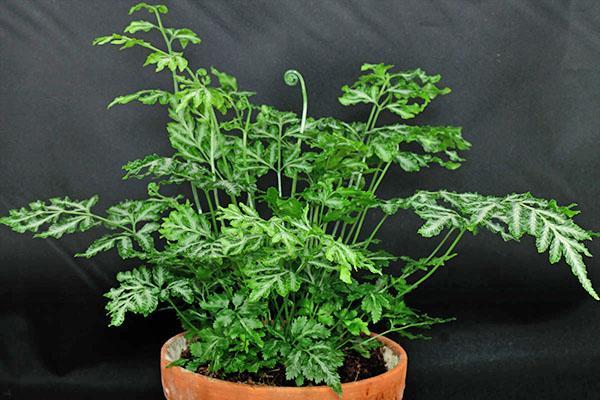Pteris: growing at home, choosing a container for planting, care, diseases, pests
 Fern pteris, which is easy to grow at home, is in great demand among lovers of decorative flowers. The plant is quite large, bright, looks beautiful in residential and office premises, even a beginner can handle its cultivation.
Fern pteris, which is easy to grow at home, is in great demand among lovers of decorative flowers. The plant is quite large, bright, looks beautiful in residential and office premises, even a beginner can handle its cultivation.
Pteris: growing at home

Pteris can be grown even under artificial lighting, providing "daylight hours" with special phyto-lamps or ordinary fluorescent lamps. The main thing is not to put the pot closer than half a meter to the lamp.
Lighting
 In the wild, pteris loves to grow in the shade of deciduous trees. Like the rest of the fern representatives, he does not like the burning rays of the sun. But too strong a shadow will damage it, the plant will lose its decorative effect. It is best to place the pot in places with a predominance of diffused light or partial shade. This can be both a window and the middle of the room. If the bright sun is shining, then the pteris is shaded with paper, tulle.
In the wild, pteris loves to grow in the shade of deciduous trees. Like the rest of the fern representatives, he does not like the burning rays of the sun. But too strong a shadow will damage it, the plant will lose its decorative effect. It is best to place the pot in places with a predominance of diffused light or partial shade. This can be both a window and the middle of the room. If the bright sun is shining, then the pteris is shaded with paper, tulle.
Temperature conditions and air humidity
 Fern tolerates cool rooms well, although it is more favorable to keep it at + 20 ° C - + 23 ° C. In summer, an increase in temperature conditions up to + 30 ° C is permissible, but do not increase the number of spraying and watering. Differences in thermometer indicators are not terrible for a plant, hot dry air is much more destructive for it. Therefore, it should be removed from the battery in winter.
Fern tolerates cool rooms well, although it is more favorable to keep it at + 20 ° C - + 23 ° C. In summer, an increase in temperature conditions up to + 30 ° C is permissible, but do not increase the number of spraying and watering. Differences in thermometer indicators are not terrible for a plant, hot dry air is much more destructive for it. Therefore, it should be removed from the battery in winter.
Basic rules for caring for pteris, which should be followed:
- regular ventilation of the room to provide fresh air;
- the temperature at night in the room is slightly lower than during the day;
- protection from drafts during the frosty season;
- keep in the fresh air only in summer, be sure to protect from rain and bright light.
Pteris is a typical fern that loves high humidity. With dry indoor air, the indoor flower is sprayed daily from a spray bottle, but always with soft or boiled water. It is good to place the pot on a tray filled with water and expanded clay, but the bottom of the container itself should not touch the water.
The choice of container and soil for planting
 The easiest option is to buy ready-made fern potting mix at the supermarket. The pot must be well drained. For this, expanded clay is used, they fill about a quarter of the container in height. IN ceramic pots there are usually holes for draining water, in plastic containers they will have to be done independently. You can drill, pierce the bottom with a hot nail or knitting needle. For large specimens, the pot must be stable.
The easiest option is to buy ready-made fern potting mix at the supermarket. The pot must be well drained. For this, expanded clay is used, they fill about a quarter of the container in height. IN ceramic pots there are usually holes for draining water, in plastic containers they will have to be done independently. You can drill, pierce the bottom with a hot nail or knitting needle. For large specimens, the pot must be stable.
The soil for pteris can be prepared independently, the main thing is that it has the ability to pass moisture and air well. The plant needs fertile soil with a slightly acidic or neutral reaction. To obtain it in equal volumes, they take sod, peat, river sand and leafy ground. Those who are engaged in planting (reproduction) of pteris do not add turf to the soil mixture; leaf land is taken 2 times less than sand and peat.
Pteris: home care
 A beautiful lush plant will delight with its appearance if it is provided with proper care. When buying pteris home, first find out the requirements of the plant and compare with your capabilities.
A beautiful lush plant will delight with its appearance if it is provided with proper care. When buying pteris home, first find out the requirements of the plant and compare with your capabilities.
How often to water pteris
 Although the plant loves moisture, the fern should be watered sparingly and only when necessary, when the topsoil in its pot is dry. With the onset of autumn, irrigation is carried out less often - only for 2-3 days after the land dries out.
Although the plant loves moisture, the fern should be watered sparingly and only when necessary, when the topsoil in its pot is dry. With the onset of autumn, irrigation is carried out less often - only for 2-3 days after the land dries out.
Water for irrigation pteris should be:
- without bleach (settled or filtered);
- room temperature;
- soft, best watered with rainwater.
From time to time in a container with a fern, the top layer of the soil must be loosened.
Top dressing of pteris
 Any indoor flower, and pteris is no exception, needs nutrients and timely feeding. It is carried out in the warm season during the active vegetation of the fern. Feeding frequency: 1 time in 14-16 days. Ready-made liquid fertilizers, focused on decorative deciduous plants, only the dosage for the fern must be reduced by 2 times. As soon as summer is over, mixes are stopped.
Any indoor flower, and pteris is no exception, needs nutrients and timely feeding. It is carried out in the warm season during the active vegetation of the fern. Feeding frequency: 1 time in 14-16 days. Ready-made liquid fertilizers, focused on decorative deciduous plants, only the dosage for the fern must be reduced by 2 times. As soon as summer is over, mixes are stopped.
Fern transplant
 Pteris rapidly grows in size, its roots are actively penetrating the earthen ball, the plant forms many shoots. Therefore, the bush is transplanted every 2-3 years. For this, a pot is prepared, which exceeds the previous capacity by 4-5 cm. If the fern is divided into several parts during transplantation, then you do not need to use a large container. It is better to transplant in the spring months. The new soil must also pass water and air well; drainage must be installed in the pot. When replanting, remove any dry or damaged leaves.
Pteris rapidly grows in size, its roots are actively penetrating the earthen ball, the plant forms many shoots. Therefore, the bush is transplanted every 2-3 years. For this, a pot is prepared, which exceeds the previous capacity by 4-5 cm. If the fern is divided into several parts during transplantation, then you do not need to use a large container. It is better to transplant in the spring months. The new soil must also pass water and air well; drainage must be installed in the pot. When replanting, remove any dry or damaged leaves.
The main problems when growing pteris
 If pteris, when grown at home, began to show signs in the form of yellowing, brown spots, the plant grows slowly or does not form shoots, then it is necessary to identify the problem and be sure to eliminate it.
If pteris, when grown at home, began to show signs in the form of yellowing, brown spots, the plant grows slowly or does not form shoots, then it is necessary to identify the problem and be sure to eliminate it.
The reasons for this may be:
- The leaf plates have become pale, almost transparent, and also sluggish - there is too much light for the plant.
- Poor growth is caused by low humidity, high indoor temperatures, poor watering and direct sunlight.
- If the fronds begin to stretch too much, become thinner, then this is a sign of insufficient illumination.
- Yellowing, browning, wilting and deformation can be caused by drafts, chlorinated water, low temperatures of the content.
- If you find insects (thrips or scale insects), you should immediately wash the fern with soapy water, treat it with an insecticide.
All the problems described above are not that difficult to solve. One has only to eliminate their causes, then the pteris will grow well, delight the owners with its decorative effect. For a plant to be healthy, you just need to properly care for it.